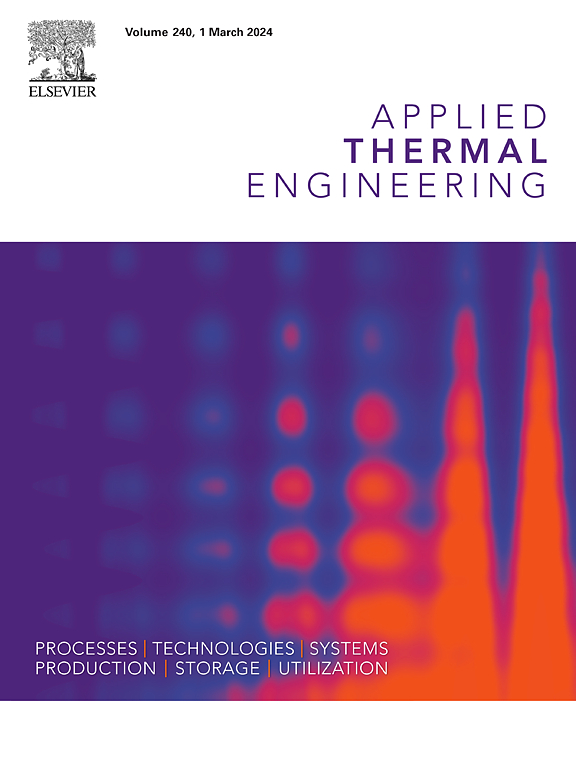电池热管理系统冷媒冷板结构设计及多准则评价
IF 6.1
2区 工程技术
Q2 ENERGY & FUELS
引用次数: 0
摘要
基于制冷剂的冷板(RCP)以其高的传热效率、强大的热安全性和优越的集成能力而越来越受到人们的关注。本文介绍了电池热管理系统(BTMS)的可变面积转轮(VAR)结构的RCP设计。通过数值模拟,从温度控制、能耗和轻量化要求等方面研究了流道结构和流动沸腾参数对其性能的影响。结果表明,流道结构参数对温度和能耗特性的敏感性存在矛盾。为此,建立了冷板性能评价指标(PEI),增强了冷板的多指标评价。结果表明,当ra = 40 mm/1mm, Re=0.0036, PEI = 1.2时,冷板性能最佳。进一步分析了流动沸腾参数对优化冷板结构的影响。结果表明,在1C至3C放电速率下,电池温度控制是有效的。当蒸发温度从10℃升高到22℃时,冷却效率降低。蒸发温度为16℃时达到最佳温度一致性。从0.02 kg/s到0.2 kg/s的制冷剂流量变化对制冷性能和能耗影响不显著。总体而言,本研究为rcp的设计和评价提供了新的概念,增强了对流道结构和流动沸腾参数对系统性能影响的理解,并为BTMS的实施提供了见解。本文章由计算机程序翻译,如有差异,请以英文原文为准。
Structural design and multi-criteria evaluation of refrigerant-based cold plate for battery thermal management system
Refrigerant-based cold plates (RCP) are increasingly attracting attention for their high heat transfer efficiency, robust thermal safety, and superior integration capabilities. This study introduces a RCP design with a variable-area runner (VAR) structure for battery thermal management system (BTMS). The impact of runner structure and flow boiling parameters on its performance is investigated from temperature control, energy consumption, and lightweight requirements through numerical simulations. It revealed that the sensitivity of runner structure parameters to temperature and energy consumption traits conflicted. Consequently, the performance evaluation index (PEI) is established to enhance the multi-criteria assessment of cold plates. The results showed that when = 40 mm/1mm, =0.0036, PEI = 1.2, the cold plate demonstrates optimal performance. Further analysis emphasizes the impact of flow boiling parameters on the optimal cold plate structure. Results indicated effective battery temperature control at 1C to 3C discharge rates. Cooling efficiency decreased as evaporation temperature increased from 10℃ to 22℃. Optimal temperature consistency achieved at the evaporation temperature of 16℃. Variation in refrigerant flow rates from 0.02 kg/s to 0.2 kg/s showed insignificant effects on cooling performance and energy consumption. Overall, this research provides new concepts for the design and evaluation of RCPs, enhances the comprehension of the influence of runner structure and flow boiling parameters on system performance, and offers insights for the implementation of BTMS.
求助全文
通过发布文献求助,成功后即可免费获取论文全文。
去求助
来源期刊

Applied Thermal Engineering
工程技术-工程:机械
CiteScore
11.30
自引率
15.60%
发文量
1474
审稿时长
57 days
期刊介绍:
Applied Thermal Engineering disseminates novel research related to the design, development and demonstration of components, devices, equipment, technologies and systems involving thermal processes for the production, storage, utilization and conservation of energy, with a focus on engineering application.
The journal publishes high-quality and high-impact Original Research Articles, Review Articles, Short Communications and Letters to the Editor on cutting-edge innovations in research, and recent advances or issues of interest to the thermal engineering community.
 求助内容:
求助内容: 应助结果提醒方式:
应助结果提醒方式:


